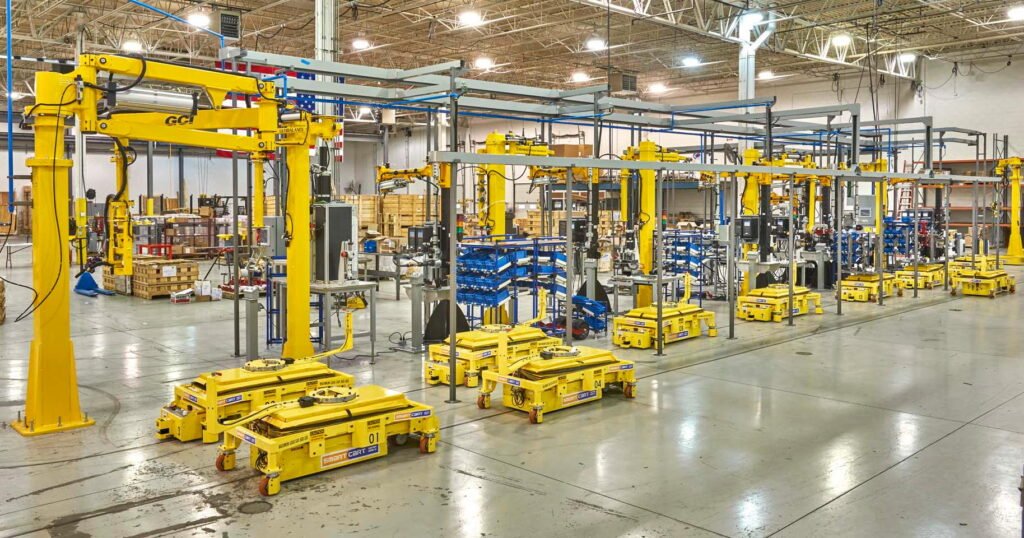ELECTRIC CRANES - STATIONARY
An essential tool for enterprises requiring steady and effective material handling are stationary electric cranes. Their precision control, energy-efficient operation, and great lifting capability make them a dependable option for a variety of uses.
Electric Cranes - Stationary
Electric cranes, which offer effective and eco-friendly methods of lifting and moving large loads, have completely transformed the material handling sector. Static electric cranes are distinguished from other varieties of electric cranes by their dependability and stability in fixed settings. This post explores the characteristics, benefits, uses, and important elements to take into account when selecting a stationary electric crane for your commercial requirements.
Electric cranes that are fixed in one place and intended to lift, move, and lower large loads with control and accuracy are known as stationary cranes. These cranes, in contrast to mobile cranes, are fixed to the ground or a structural base, offering a secure platform for material handling in settings including factories, ports, and warehouses. Because they run on electric motors, they are an environmentally responsible and energy-efficient option for businesses trying to maximize productivity.


- Easy Installations.
- No fuel required for its operation.
- Optimum efficiency in lifting and dumping the scrap.
- Maximum lift performance.
- High load bearing capacity.
- Easy Handling of material with low maintainance cost under Eco-friendly working conditions.


- The Grab is designed to handle a large number of materials in Irregular shapes such as blocksncubes and within wide range of it.
Features of Electric Cranes - Stationary
High Stability and Precision
Because of their solid base, stationary cranes provide great stability and enable precise load lifting and positioning. For applications needing high accuracy and safety, this stability is vital.
Energy-Efficient Operation
Static cranes that run on electric motors use less energy than those that run on diesel. They are therefore a popular option for many businesses due to their decreased environmental.
Customizable
Designs
Electric stationary cranes can be customized to meet certain industrial requirements. These cranes can be modified to effectively manage a range of jobs, from distinct lifting capacity.
Advanced Control Systems
Accurate load management is made possible by sophisticated control systems found in modern stationary cranes. Functionalities such as joystick controllers, touchscreen interfaces.
Advantages of Using Stationary Electric Cranes
- Enhanced Stability for Heavy Lifting
- Reduced Operating Costs
- High Lifting Capacity
- Long-Term Durability
Because of their solid base, stationary cranes offer a stable lifting solution, which makes them perfect for situations requiring accuracy and stability. This is especially helpful in manufacturing facilities and warehouses where fragile goods or large gear are handled.
Safety
Stability is directly linked to the safety of crane operations. An unstable crane can lead to tipping, load swinging, or even catastrophic failures. By ensuring enhanced stability, the risk of accidents is significantly reduced, protecting both workers and equipment.Load Control
With enhanced stability, operators have greater control over the movement of heavy loads. This is essential for tasks that require precise positioning, such as assembling large components in manufacturing or placing materials in specific locations on construction sites.Efficiency
Stable cranes can operate more efficiently because there is less time spent on corrective actions to stabilize the load. This results in faster operations, reduced downtime, and increased productivity.
Operating costs for stationary cranes are greatly decreased by the use of electric motors. Electric cranes are less energy-consuming and require less maintenance than traditional fuel-powered cranes. Long-term savings and a smaller carbon footprint result from this.
Energy Efficiency: Electric cranes convert a higher percentage of energy into useful work compared to internal combustion engines. This means less energy is wasted, resulting in lower electricity bills.
Stable Energy Prices: Electricity prices tend to be more stable compared to the fluctuating costs of fuel. This stability allows businesses to better predict and manage their operating expenses.
Opportunity for Renewable Energy: Electric cranes can be powered using renewable energy sources such as solar or wind power, further reducing costs and contributing to sustainable business practices.
Elevated loads up to several tons can be lifted by stationary electric cranes. This makes them appropriate for sectors like steel manufacture and logistics that work with large, heavy goods.
Increased Efficiency
Cranes with high lifting capacities can lift heavier loads in a single operation, reducing the number of lifts required for a task. This increases overall efficiency by minimizing the time and effort needed to complete heavy lifting operations.Versatility in Handling Large Objects
High-capacity cranes are designed to manage a wide range of heavy and oversized objects, making them suitable for various applications such as lifting large steel beams, heavy machinery, shipping containers, and prefabricated building components.Enhanced Safety
Using equipment with the appropriate lifting capacity minimizes the risk of overloading, which can lead to dangerous situations such as equipment failure or tipping. High-capacity cranes are engineered with robust safety features to handle heavy loads securely.Cost-Effectiveness
Although high-capacity cranes may have a higher initial investment, they can lead to long-term savings by reducing the need for multiple smaller cranes, minimizing operational disruptions, and decreasing labor costs through faster project completion.Support for Complex Projects
In industries like construction and heavy manufacturing, complex projects often require lifting large, heavy, and awkwardly shaped components. High-capacity cranes provide the necessary strength and stability to manage these demanding tasks effectively.
Static electric cranes are made of sturdy materials and are intended for heavy-duty applications. They are long-lasting. Because of their permanent position, which minimizes wear and tear on moving parts, they can operate for longer stretches of time with less downtime.
Reduced Maintenance Costs
Durable equipment requires less frequent servicing and fewer repairs, which can significantly lower maintenance costs. This includes savings on replacement parts, labor, and downtime associated with maintenance activities.Increased Operational Uptime
Long-lasting equipment is less prone to unexpected failures, leading to higher operational uptime. This is particularly important in industries where equipment downtime can cause costly delays and disrupt production schedules.Lower Total Cost of Ownership (TCO)
Although durable equipment may have a higher initial purchase price, the overall cost of ownership is lower due to reduced maintenance, repair, and replacement costs over the equipment’s lifespan.Enhanced Safety
Durable equipment maintains its structural integrity and performance standards over time, reducing the risk of accidents caused by equipment failure. This is critical in environments where safety is a top priority, such as construction sites and industrial facilities.Sustained Performance
Equipment designed for durability delivers consistent performance, even after years of use. This reliability ensures that productivity remains high and that the equipment can continue to meet operational demands.
Applications of Stationary Electric Cranes

Manufacturing and Assembly Lines
Static electric cranes are used in manufacturing facilities to transport large equipment, unfinished goods, and raw materials along assembly lines. They are essential to the production of heavy machines and automobiles due to their precise lifting and positioning abilities.

Warehousing and Storage Facilities
For warehousing operations, stationary cranes are perfect since they help stack and arrange large inventories. By raising items to higher storage racks, they facilitate more effective use of available space by increasing accessibility and total storage capacity.

Ports and Shipyards
Static electric cranes are used at ports and shipyards to load and unload cargo from vessels. They are ideal for handling containers and other heavy items securely and effectively because to their great lifting capability and stable operation.

Construction Sites
Although mobile cranes are frequently seen on building sites, stationary electric cranes are sometimes employed in fixed places, such as raised platforms or building rooftops, to raise goods to predetermined heights. When space is limited and accuracy is needed, they offer a reliable lifting option.
